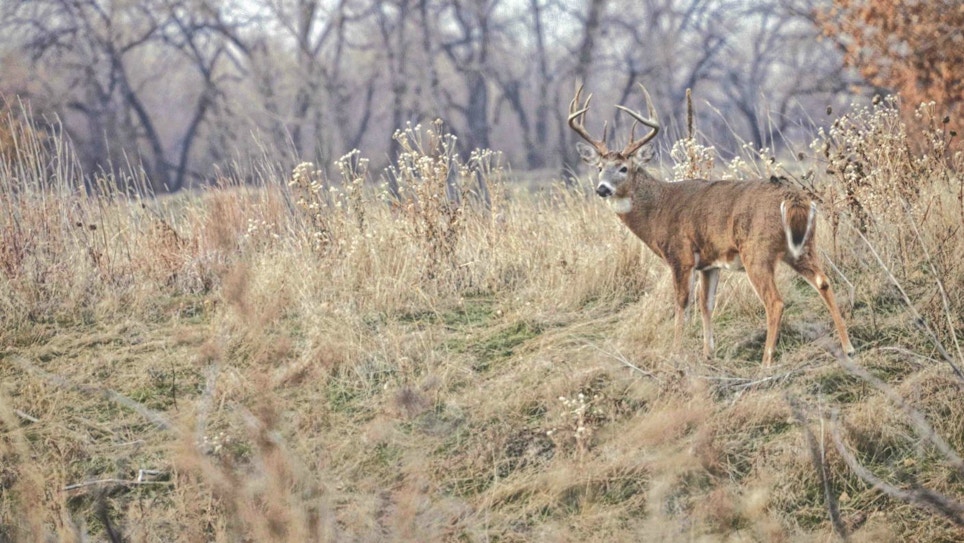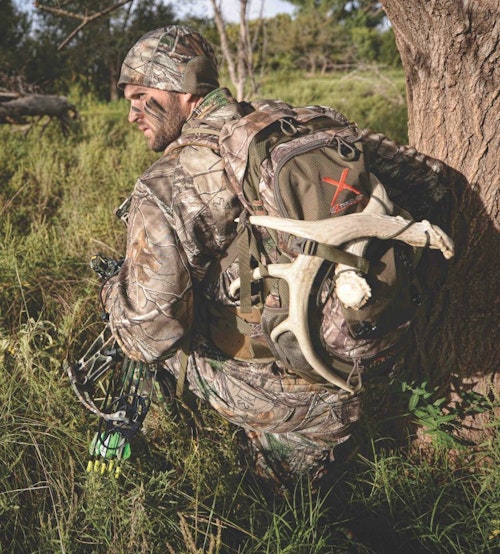With first light beginning to break, I eased into the creek channel with my hip boots. Unseasonably high levels of rain in the past three weeks had turned Fall Creek’s typical ankle-deep trickle into a constant muddy flow Knee-high rubber boots weren’t sufficient. I had learned this the hard way a few days prior, which quickly put an end to an evening hunt. Prepared this time, I eased against the creek’s flow for 150 yards and slipped up the steep bank to my stand.
I hunt this setup only on special occasions, and today was one of those times. It was the second week of November and a cold front had just barreled through the evening before. For a whitetail hunter, it’s a day worth celebrating, and I eagerly climbed the stand. The rut was in full swing, this stand was positioned on the downwind edge of a primary doe bedding area. My confidence was high.
Deer typically don’t start arriving until the first hour or so into shooting light, and this day was no different. About that time, a solitary two-year-old buck suddenly appeared and slowly sneaked beneath my stand, pausing every few steps to scent check the light breeze. He needed a couple years to mature, and I enjoyed watching his heightened senses work in overdrive as he moved out of sight.
As the minutes ticked past, I began to see the broken outlines of deer trickling in to the bedding area. Grabbing my rattling horns and grunt tube, I put them to work. The clash of bone and the rumble of grunts cut through the silence of the cold November morning, and after 30 seconds of this fictitious rumble, I traded horns for my bow. In no time, a young 4x3 wandered in with head cocked looking for trouble, and he was quickly followed by a slightly larger 4x4.
Several young bucks and does eased by within bow range throughout the morning, but it wasn’t until a known buck appeared that I thought my luck was about to change. When he eased out of sight, I grabbed the horns again and cracked them together. In a matter of seconds, the buck reappeared through the screen of brush. His 5x5 frame was impressive, and it would no doubt match the 170-inch brute my cousin killed on the same farm the previous season. Sixty yards quickly melted into 40, but when he paused, his vitals were hidden from view.
All I could do was watch and hope the buck would take the step I needed to open an opportunity for my arrow. However, curiosity doesn’t always kill the cat, and with no interlopers present, he knew something was awry and slowly eased away.
Offseason Finds
When locating and hunting doe bedding areas, attention to detail is important. Ideally, you want to find them well before the season, but when the rut is in full swing, sometimes you need to throw a little caution to the wind and make something happen. Look for areas where heavy brush intersects with ideal travel corridors such as creeks, draws and benches. Obviously the best time to scout them internally is at the end of the season when alerting deer will not be a factor.
Unlike stands located near funnels, ridges or other common travel corridors, bedding areas are more general in nature, so it tends to be more difficult to predict how deer will enter them. These areas can be as large as a few acres or as small as a backyard, and there’s usually no rhyme or reason as to how they will be used during the day. Deer may bed in a particular area one day, and then in a different spot the next based on wind direction, weather, hunting pressure or mood. Because of this, the only safe and effective stand location is on the downwind edge.
Ideally, it would be best to hang treestands in these locations well-before the season, but if that’s not possible, use a strong wind or rain to mask noise and disperse scent. A hang-and-hunt setup well-before first light has worked for me more than once as well.
Get It Right
Picking the right bedding area is also important. Although all bedding areas will hold deer, not all are created equal for hunting. The real chess match is not finding a bedding area that holds the most family groups of does, but finding ones that allow you to get to and from your stand without alerting its residents. Regardless of how good it looks or how big the buck is you’re targeting, it will not be a great stand if you can’t hunt it, access it or exit it without being detected.
I like to use creeks and ditches as access points, especially when close to these locations. Not only do these features hide your approach, but just as important, they also give you an optimal exit route when it’s time to call it a day. Keep in mind also that using ditches and creeks as your travel route may require some preseason preparation. Often times these areas are prone to heavy lay-downs, log jams and thick brush that needs to be removed before the season begins in order to keep unwanted noise to a minimum.
When picking the right bedding area, consider where the prominent feeding areas are so you can determine the likely direction the deer will be going during the morning and evening hours. Ideally, you want to approach these stands when the wind is blowing from the most prominent feeding area toward the bedding area. Only hunt this stand when the wind is right and always approach it from a downwind angle so you can slip in the back door.
When to Hunt
The most exciting time to hunt a bedding area is during the pre-rut. Bucks will be on their feet checking the downwind edge of multiple bedding areas throughout the day. Adding some grunts and rattling into the mix, without overdoing it, can make a good November morning into a great one. In fact, it wasn’t too many seasons ago that I rattled in a dozen different bucks one morning from that same tree.
These areas can be just as good in late November as well. Although you tend to see less rut activity overall then, mature bucks are still on the move as they search for another doe to breed. In fact, I have seen some bucks stretch their core rut area a little farther this time of year, so you never know who might show up. While calling can be effective at that time, I tend to tone it down considerably.
Finally, because there is more inherent risk involved when hunting any bedding areas compared to other stand locations, these setups can easily be over-hunted. Even when taking extreme precautions with stand preparation, scent management, scouting, access and wind direction, these stand locations should be hunted only on a limited basis. Personally, I tend to hunt them only twice during a 7-day period, and in some circumstances once a week is enough. Your first hunt will more than likely be your best, so use it when conditions are optimal. For me, I don’t mind rolling the dice a bit during the end of deer season.
Sidebar: My Go-To Whitetail Gear
Besides having the ability to provide accurate reading out to a mile, the feature-rich Nitro from Bushnell incorporates their exclusive Angle Range Compensation (ARC) technology that provides true horizontal distance; Brush Mode that is designed to ignore brush and tree branches in the foreground; Bullseye Mode which acquires ranges of small targets without inadvertently measuring background target distances and when more than one object is acquired, the closer of the two objects is shown on the LCD display and the typical Scan Mode. The Nitro’s forged polymer armor housing and EXO Barrier coating repels rain, snow, oil, dust and debris.
G5’s Striker V2 features a cut-on-contact 100-percent stainless steel design, and like its popular predecessor, has extremely sharp Lutz blades that easily zips through heavy big game. Its blade retention system is super strong, increasing the broadhead’s reliability, while still keeping blade replacement extremely simple. The ferrule of the Striker V2 is fully developed from machined stainless steel and has a cutting diameter of 1.25-inches.
Continuing to expand their footprint into the extreme-duty hunting pack arena, ALPS OutdoorZ is offering the new Contender X Whitetail Pack this season. It has plenty of room for those all-day hunts with its spacious 1,850 cubic inch carrying capacity, plus the large U-shaped heavy-duty zipper on the top panel makes it easy to grab gear quietly. The additional pockets can be accessed both internally and externally to quickly grab gear when seconds count and its comfortable molded foam suspension system includes load lifters for weight distribution when you need to haul out some bone.
Building upon the successful Frontier series last year, Hawke introduced the new Frontier HD X binocular. At a price any bowhunter can afford, the Frontier HD X features high definition quality with incredible color control and phase correction. Exceptional lens coatings on all surfaces throughout, plus high-resolution Phase Corrected BAK-4 roof prisms and dielectric coated prisms, ensures the highest amount of light transmission and clarity. Available in both 8X and 10X42 options, the Frontier HD X is both water and fog proof and is built from a lightweight rubber coated magnesium alloy chassis.








